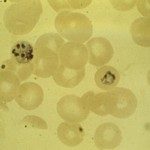Lien vers Pubmed [PMID] – 4331256
Biochem J 1971 Aug; 124(1): 241-8
1. Pig lymphocytes were transformed by dibutyryl cyclic AMP (6-N,2′-O-dibutyryladenosine 3′:5′-cyclic monophosphate) at concentrations of 0.01-0.1mum. The pattern of incorporation of label from [5-(3)H]uridine and [6-(3)H]thymidine into RNA and DNA respectively was identical with that obtained with unpurified phytohaemagglutinin. 2. Chlorpromazine (0.1mum) prevented the stimulation of [5-(3)H]uridine incorporation into RNA by phytohaemagglutinin, but only slightly lowered the lymphocyte response to dibutyryl cyclic AMP. 3. An increase in the size and specific radioactivity of the intracellular P(i) pool was found immediately after stimulation by both phytohaemagglutinin and dibutyryl cyclic AMP. This was followed after some 30min by a rise in the specific radioactivity and concentration of ATP. 4. There was an immediate increase in the specific radioactivity of phosphate groups of histones; by about 45min after stimulation only the histones remaining after extraction of histone fraction F1 continued to incorporate (32)P from [(32)P]P(i). 5. Histone kinase activity increased in the first 30min after stimulation; subsequently histone F1 kinase activity decreased, but activity with the other histones as substrate continued to increase for a further 30min. Kinase activation was effected by cyclic AMP (adenosine 3′:5′-cyclic monophosphate). 6. Histone phosphatase activity behaved similarly to that of the kinase.

